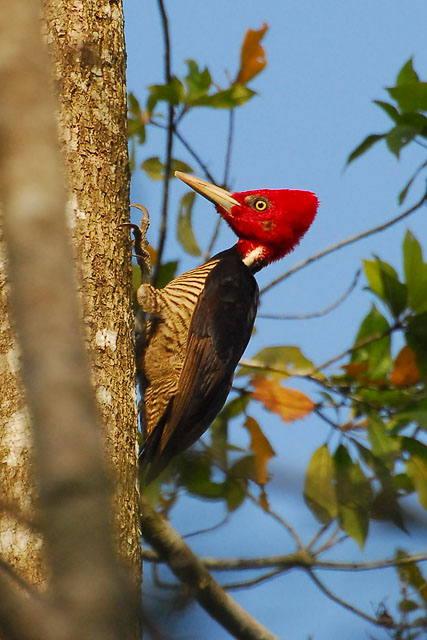- Pale-billed Woodpecker
Taxobox
name = Pale-billed Woodpecker

status = LC | status_system = IUCN3.1
regnum =Animal ia
phylum = Chordata
classis = Aves
ordo =Piciformes
familia =Picidae
genus = "Campephilus "
species = "C. guatemalensis"
binomial = "Campephilus guatemalensis"
binomial_authority = Reichenbach, 1854The Pale-billed Woodpecker ("Campephilus guatemalensis") is a very large
woodpecker which is a resident breedingbird from northernMexico to westernPanama .Habitat
The habitat of this species is wet forests and adjacent second growth or semi-open woodland. Two white eggs are laid in an unlined nest hole 3-30 m high in a tree and incubated by both sexes. The young hatch naked and are fed by both parents.
Description
The Pale-billed Woodpecker is 37 cm long and weighs 255g. It resembles the
Lineated Woodpecker , but is larger and more robust.The adult is mainly black above with a pale bill, bushy crest, and white lines down the shoulders which almost meet in a V on its back. The throat is black and the rest of the underparts are white, heavily barred with black. The male has a red head and crest; the female is similar, but the crest and throat are black. The female can be distinguished from Lineated Woodpecker by the absence of a white facial stripe.
This bird has a diagnostice drumming with two quick powerful taps. Its call include nasal rattles and a "keeu keeu keeu keeu" breeding call.
Pale-billed Woodpeckers chip out holes, often quite large, while searching out
insect s in trees. They mainly eatbeetle larva e, with some berries or other fruit.This bird has been adversely affected by deforestation in parts of its range.
References
* Stiles and Skutch, "A guide to the birds of Costa Rica" ISBN 0-8014-9600-4
Wikimedia Foundation. 2010.
